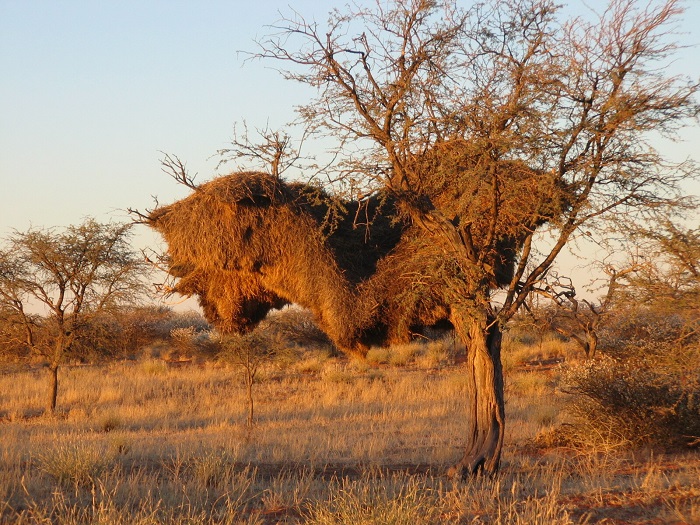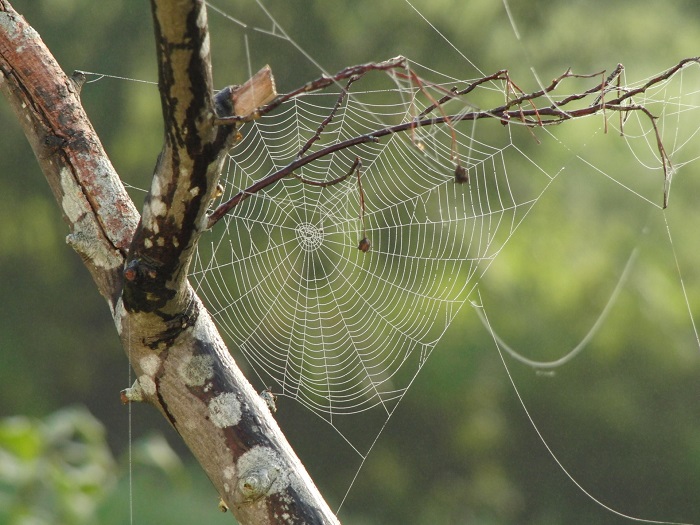ISABEL RUBIO ARROYO | Tungsteno
De nidos gigantes que retienen el calor a termiteros con un sofisticado sistema de ventilación. El mundo animal tiene sus propias maravillas de ingeniería que, en muchas ocasiones, pueden convertirse en una fuente de inspiración para arquitectos y constructores. Repasamos la optimización energética que persiguen algunas estructuras únicas en la naturaleza.
Nidos gigantescos para mantener el calor
Los nidos de los tejedores republicanos (Philetairus socius) probablemente sean las estructuras más espectaculares construidas por cualquier ave. Algunos miden seis metros de ancho, pesan una tonelada y conforman el hogar de hasta 500 ejemplares. Los tejedores republicanos, que habitan en países de África como Namibia o Botsuana, aprovechan los árboles u otros objetos altos para construir estos nidos coloniales.
Un estudio publicado en la revista PLOS ONE indica que estas aves se comportan de forma agresiva con los ejemplares que no ayudan a construir el techo principal de paja del nido y, en su lugar, trabajan en cámaras individuales. El objetivo de este comportamiento, según los investigadores, sería fomentar la cooperación por el bien del grupo.
Estos nidos son el resultado del trabajo de varias generaciones de aves y pueden ser utilizadas durante décadas. Pero, además de por sus gigantescas dimensiones, destacan porque están muy estructurados y proporcionan a las aves una temperatura más ventajosa en relación con el exterior. Las cámaras centrales de estos nidos retienen el calor y normalmente son utilizadas para pasar la noche. Las externas tienen una temperatura más baja y son usadas durante el día. Las aves más longevas ocupan las cámaras con mayores beneficios termorreguladores, según un artículo publicado en la revista de ornitología Journal of Avian Biology. En estos compartimentos también es más común la actividad reproductiva.

Los tejedores republicanos construyen nidos que pueden medir seis metros de ancho y pesar una tonelada. Crédito: Harald Süpfle / Creative Commons.
Telarañas que buscan el sol
Para favorecer la termorregulación, múltiples estructuras del mundo animal se construyen teniendo en cuenta la orientación. Es el caso de las telarañas de la araña espinosa (Micrathena gracilis). Los ejemplares en microhábitats sombreados suelen estar orientados hacia el norte o el sur mientras que aquellos en entornos bien iluminados miran hacia el este o el oeste. La orientación de la telaraña influye en la cantidad de radiación a la que está expuesta una araña. Tanto una temperatura corporal demasiado baja como una excesiva pueden afectar la actividad de este animal, según una investigación publicada en la revista Ecology.
Las arañas son uno de los grupos de especies más antiguos y diversos de la tierra: aproximadamente se han identificado unas 45.000 especies diferentes. Normalmente son depredadores generalistas, es decir, no se especializan en un tipo particular de presa. Conocidas por tejer telarañas de lo más sofisticadas, han ido cambiando sus telas para adaptarse mejor a hábitats complicados.
De hecho, durante millones de años también han ideado diferentes estrategias para atrapar presas. Por ejemplo, los mimétidos (Mimetidae) devoran a otras arañas en sus propias redes haciéndose pasar por presas. Algunas especies recurren a patrones decorativos en sus telarañas para conseguir un mayor botín. En algunos casos, estos patrones reflejan además luz ultravioleta, lo que puede servir para engañar y atraer a más insectos. Es precisamente lo que pretenden con sus estructuras las arañas avispa, que utilizan patrones en zigzag que parten del centro de la telaraña. "Los efectos de estos patrones en la cantidad de insectos parecen deberse a su impacto en insectos polinizadores sensibles a la luz ultravioleta", afirma Kil Won Kim, científico de la Universidad de Incheon, en Corea del Sur.

Algunas arañas construyen sus telas teniendo en cuenta cuál es la mejor orientación. Crédito: Pixabay.
Termiteros con un sofisticado sistema de ventilación
En el noreste de Brasil hay una red masiva de 200 termiteros que ocupa una superficie del tamaño de Gran Bretaña. El volumen de tierra movido para crear todos estos montículos equivale a 10 kilómetros cúbicos. O lo que es lo mismo, 4.000 pirámides de Giza, según un artículo publicado en la revista científica Current Biology. Todos estos montículos han sido creados por termitas. Estos insectos de un tamaño milimétrico han excavado durante muchos siglos una gran red de túneles interconectados para poder acceder a las hojas muertas del bosque.
Existen más de 3.000 especies de termitas. Muchas son constructoras que buscan proteger a sus reinas y asegurar que sobrevivan sus colonias. Para levantar los termiteros, utilizan su saliva, los excrementos y la tierra circundante. Estos montículos normalmente cuentan con una cámara principal subterránea y una estructura superior porosa que permite que el aire exterior entre sin problemas. Algunos alojan a millones de individuos, llegando a alcanzar una altura de 8 metros y un diámetro de unos 30 metros.
Sus redes de túneles sirven para que el CO2 salga de los montículos y entre el oxígeno. Además de ser utilizadas como sistema de ventilación, permiten regular el calor y la humedad en los montículos. El aire caliente circula por los túneles y es impulsado por las corrientes desde las galerías inferiores hacia afuera. Esto es importante para evitar que el nido se sobrecaliente. Las termitas se encargan de mantener los túneles, abrir nuevos o bloquear algunos existentes para optimizar este sistema de termorregulación.
Las termitas utilizan saliva, excrementos y la tierra circundante para levantar estos montículos. Crédito: Cell Press.
· — —
Tungsteno es un laboratorio periodístico que explora la esencia de la innovación. Ideado por Materia Publicaciones Científicas para el blog de Sacyr.
